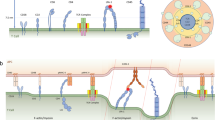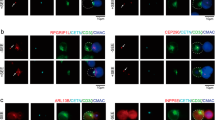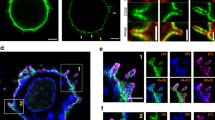Abstract
Immunological synapses are initiated by signaling in discrete T cell antigen receptor microclusters and are important for the differentiation and effector functions of T cells. Synapse formation involves the orchestrated movement of microclusters toward the center of the contact area with the antigen-presenting cell. Microcluster movement is associated with centripetal actin flow, but the function of motor proteins is unknown. Here we show that myosin IIA was necessary for complete assembly and movement of T cell antigen receptor microclusters. In the absence of myosin IIA or its ATPase activity, T cell signaling was interrupted 'downstream' of the kinase Lck and the synapse was destabilized. Thus, T cell antigen receptor signaling and the subsequent formation of immunological synapses are active processes dependent on myosin IIA.
This is a preview of subscription content, access via your institution
Access options
Subscribe to this journal
Receive 12 print issues and online access
$209.00 per year
only $17.42 per issue
Buy this article
- Purchase on Springer Link
- Instant access to full article PDF
Prices may be subject to local taxes which are calculated during checkout







Similar content being viewed by others
References
Davis, M.M. The αβ T cell repertoire comes into focus. Immunity 27, 179–180 (2007).
DeMond, A.L., Mossman, K.D., Starr, T., Dustin, M.L. & Groves, J.T. T cell receptor microcluster transport through molecular mazes reveals mechanism of translocation. Biophys. J. 94, 3286–3292 (2008).
Monks, C.R., Freiberg, B.A., Kupfer, H., Sciaky, N. & Kupfer, A. Three-dimensional segregation of supramolecular activation clusters in T cells. Nature 395, 82–86 (1998).
Dustin, M.L. et al. A novel adaptor protein orchestrates receptor patterning and cytoskeletal polarity in T-cell contacts. Cell 94, 667–677 (1998).
Grakoui, A. et al. The immunological synapse: a molecular machine controlling T cell activation. Science 285, 221–227 (1999).
Jacobelli, J., Chmura, S.A., Buxton, D.B., Davis, M.M. & Krummel, M.F. A single class II myosin modulates T cell motility and stopping, but not synapse formation. Nat. Immunol. 5, 531–538 (2004).
Combs, J. et al. Recruitment of dynein to the Jurkat immunological synapse. Proc. Natl. Acad. Sci. USA 103, 14883–14888 (2006).
Bunnell, S.C. et al. T cell receptor ligation induces the formation of dynamically regulated signaling assemblies. J. Cell Biol. 158, 1263–1275 (2002).
Campi, G., Varma, R. & Dustin, M.L. Actin and agonist MHC-peptide complex-dependent T cell receptor microclusters as scaffolds for signaling. J. Exp. Med. 202, 1031–1036 (2005).
Huse, M. et al. Spatial and temporal dynamics of T cell receptor signaling with a photoactivatable agonist. Immunity 27, 76–88 (2007).
Yokosuka, T. et al. Newly generated T cell receptor microclusters initiate and sustain T cell activation by recruitment of Zap70 and SLP-76. Nat. Immunol. 6, 1253–1262 (2005).
Douglass, A.D. & Vale, R.D. Single-molecule microscopy reveals plasma membrane microdomains created by protein-protein networks that exclude or trap signaling molecules in T cells. Cell 121, 937–950 (2005).
Varma, R., Campi, G., Yokosuka, T., Saito, T. & Dustin, M.L. T cell receptor-proximal signals are sustained in peripheral microclusters and terminated in the central supramolecular activation cluster. Immunity 25, 117–127 (2006).
Lee, K.H. et al. The immunological synapse balances T cell receptor signaling and degradation. Science 302, 1218–1222 (2003).
Dustin, M.L. & Cooper, J.A. The immunological synapse and the actin cytoskeleton: molecular hardware for T cell signaling. Nat. Immunol. 1, 23–29 (2000).
Chakraborty, A.K. How and why does the immunological synapse form? Physical chemistry meets cell biology. Sci. STKE 2002, PE10 (2002).
Kaizuka, Y., Douglass, A.D., Varma, R., Dustin, M.L. & Vale, R.D. Mechanisms for segregating T cell receptor and adhesion molecules during immunological synapse formation in Jurkat T cells. Proc. Natl. Acad. Sci. USA 104, 20296–20301 (2007).
Lin, C.H., Espreafico, E.M., Mooseker, M.S. & Forscher, P. Myosin drives retrograde F-actin flow in neuronal growth cones. Neuron 16, 769–782 (1996).
Conti, M.A. & Adelstein, R.S. Nonmuscle myosin II moves in new directions. J. Cell Sci. 121, 11–18 (2008).
Tan, J.L., Ravid, S. & Spudich, J.A. Control of nonmuscle myosins by phosphorylation. Annu. Rev. Biochem. 61, 721–759 (1992).
Simons, M. et al. Human nonmuscle myosin heavy chains are encoded by two genes located on different chromosomes. Circ. Res. 69, 530–539 (1991).
Golomb, E. et al. Identification and characterization of nonmuscle myosin II–C, a new member of the myosin II family. J. Biol. Chem. 279, 2800–2808 (2004).
Maupin, P., Phillips, C.L., Adelstein, R.S. & Pollard, T.D. Differential localization of myosin-II isozymes in human cultured cells and blood cells. J. Cell Sci. 107, 3077–3090 (1994).
Wulfing, C. & Davis, M.M. A receptor/cytoskeletal movement triggered by costimulation during T cell activation. Science 282, 2266–2269 (1998).
Straight, A.F. et al. Dissecting temporal and spatial control of cytokinesis with a myosin II Inhibitor. Science 299, 1743–1747 (2003).
Blanchard, N. et al. Strong and durable TCR clustering at the T/dendritic cell immune synapse is not required for NFAT activation and IFN-γ production in human CD4+ T cells. J. Immunol. 173, 3062–3072 (2004).
Ilani, T., Khanna, C., Zhou, M., Veenstra, T.D. & Bretscher, A. Immune synapse formation requires ZAP-70 recruitment by ezrin and CD43 removal by moesin. J. Cell Biol. 179, 733–746 (2007).
Weiss, A., Imboden, J., Shoback, D. & Stobo, J. Role of T3 surface molecules in human T-cell activation: T3-dependent activation results in an increase in cytoplasmic free calcium. Proc. Natl. Acad. Sci. USA 81, 4169–4173 (1984).
Valitutti, S., Muller, S., Cella, M., Padovan, E. & Lanzavecchia, A. Serial triggering of many T-cell receptors by a few peptide-MHC complexes. Nature 375, 148–151 (1995).
Krogsgaard, M. et al. Agonist/endogenous peptide-MHC heterodimers drive T cell activation and sensitivity. Nature 434, 238–243 (2005).
Janeway, C.A. Jr. & Bottomly, K. Responses of T cells to ligands for the T-cell receptor. Semin. Immunol. 8, 108–115 (1996).
Sims, T.N. et al. Opposing effects of PKCθ and WASp on symmetry breaking and relocation of the immunological synapse. Cell 129, 773–785 (2007).
Barda-Saad, M. et al. Dynamic molecular interactions linking the T cell antigen receptor to the actin cytoskeleton. Nat. Immunol. 6, 80–89 (2005).
Dustin, M.L. & Springer, T.A. T-cell receptor cross-linking transiently stimulates adhesiveness through LFA-1. Nature 341, 619–624 (1989).
Fleire, S.J. et al. B cell ligand discrimination through a spreading and contraction response. Science 312, 738–741 (2006).
Giannone, G. et al. Lamellipodial actin mechanically links myosin activity with adhesion-site formation. Cell 128, 561–575 (2007).
Pasternak, C., Spudich, J.A. & Elson, E.L. Capping of surface receptors and concomitant cortical tension are generated by conventional myosin. Nature 341, 549–551 (1989).
Mabuchi, I. & Okuno, M. The effect of myosin antibody on the division of starfish blastomeres. J. Cell Biol. 74, 251–263 (1977).
Matsumura, F. Regulation of myosin II during cytokinesis in higher eukaryotes. Trends Cell Biol. 15, 371–377 (2005).
Munro, E., Nance, J. & Priess, J.R. Cortical flows powered by asymmetrical contraction transport PAR proteins to establish and maintain anterior-posterior polarity in the early C. elegans embryo. Dev. Cell 7, 413–424 (2004).
Mescher, M.F. Surface contact requirements for activation of cytotoxic T lymphocytes. J. Immunol. 149, 2402–2405 (1992).
Galbraith, C.G., Yamada, K.M. & Sheetz, M.P. The relationship between force and focal complex development. J. Cell Biol. 159, 695–705 (2002).
Lillemeier, B.F., Pfeiffer, J.R., Surviladze, Z., Wilson, B.S. & Davis, M.M. Plasma membrane-associated proteins are clustered into islands attached to the cytoskeleton. Proc. Natl. Acad. Sci. USA 103, 18992–18997 (2006).
Gallagher, P.J., Herring, B.P., Griffin, S.A. & Stull, J.T. Molecular characterization of a mammalian smooth muscle myosin light chain kinase. J. Biol. Chem. 266, 23936–23944 (1991).
Ludowyke, R.I., Peleg, I., Beaven, M.A. & Adelstein, R.S. Antigen-induced secretion of histamine and the phosphorylation of myosin by protein kinase C in rat basophilic leukemia cells. J. Biol. Chem. 264, 12492–12501 (1989).
Koretzky, G.A., Abtahian, F. & Silverman, M.A. SLP76 and SLP65: complex regulation of signalling in lymphocytes and beyond. Nat. Rev. Immunol. 6, 67–78 (2006).
Zeng, R. et al. SLP-76 coordinates Nck-dependent Wiskott-Aldrich syndrome protein recruitment with Vav-1/Cdc42-dependent Wiskott-Aldrich syndrome protein activation at the T cell-APC contact site. J. Immunol. 171, 1360–1368 (2003).
Dustin, M.L. & Springer, T.A. Lymphocyte function-associated antigen-1 (LFA-1) interaction with intercellular adhesion molecule-1 (ICAM-1) is one of at least three mechanisms for lymphocyte adhesion to cultured endothelial cells. J. Cell Biol. 107, 321–331 (1988).
Vasiliver-Shamis, G. et al. HIV-1 envelope gp120 induces a stop signal and virological synapse formation in non-infected CD4+ T cells. J. Virol. 82, 9445–9457 (2008).
Bretscher, A. Rapid phosphorylation and reorganization of ezrin and spectrin accompany morphological changes induced in A-431 cells by epidermal growth factor. J. Cell Biol. 108, 921–930 (1989).
Acknowledgements
We thank D. Garbett for help with data analysis with Volocity and for comments, and D.W. Pruyne for help in setting up DIC microscopy. Supported by the European Molecular Biology Organization (T.I.) and the US National Institutes of Health (GM36652 to A.B.; and AI44931 and Nanomedicine Development Center EY16586 to M.L.D.).
Author information
Authors and Affiliations
Contributions
The laboratories of A.B. and M.L.D. did independent work on the involvement of myosin IIA in the formation of immunological synapses and continued the work collaboratively focusing on studies in the human system initiated by T.I. and A.B.; T.I. conceived and did the experiments in Figures 2, 3, 4, 5a,b and 6; T.I., G.V.-S. and S.V. collaborated on Figures 1, 5c and 7; and T.I. and A.B. wrote the first draft of the manuscript, which M.L.D. extensively edited and revised.
Corresponding authors
Supplementary information
Supplementary Text and Figures
Supplementary Figures 1–8 (PDF 3739 kb)
Supplementary Movie 1
Jurkat T cells (movies S1–S3, S7) or primary human CD4 cells (movies S4–S6) pre treated with DMSO (movies S1 and S4), blebbistatin (movies S2 and S5) or ML7 (movies S3 and S67) were added to planer a lipid bilayer containing Alexa-568 labeled OKT3 and ICAM1, and imaged during the initial min of synapse formation by TIRF microscopy. In movie S7 blebbistatin was added to the flow cell following initial contact and microcluster formation. (AVI 137 kb)
Supplementary Movie 2
Jurkat T cells (movies S1–S3, S7) or primary human CD4 cells (movies S4–S6) pre treated with DMSO (movies S1 and S4), blebbistatin (movies S2 and S5) or ML7 (movies S3 and S67) were added to planer a lipid bilayer containing Alexa-568 labeled OKT3 and ICAM1, and imaged during the initial min of synapse formation by TIRF microscopy. In movie S7 blebbistatin was added to the flow cell following initial contact and microcluster formation. (AVI 1007 kb)
Supplementary Movie 3
Jurkat T cells (movies S1–S3, S7) or primary human CD4 cells (movies S4–S6) pre treated with DMSO (movies S1 and S4), blebbistatin (movies S2 and S5) or ML7 (movies S3 and S67) were added to planer a lipid bilayer containing Alexa-568 labeled OKT3 and ICAM1, and imaged during the initial min of synapse formation by TIRF microscopy. In movie S7 blebbistatin was added to the flow cell following initial contact and microcluster formation. (AVI 602 kb)
Supplementary Movie 4
Jurkat T cells (movies S1–S3, S7) or primary human CD4 cells (movies S4–S6) pre treated with DMSO (movies S1 and S4), blebbistatin (movies S2 and S5) or ML7 (movies S3 and S67) were added to planer a lipid bilayer containing Alexa-568 labeled OKT3 and ICAM1, and imaged during the initial min of synapse formation by TIRF microscopy. In movie S7 blebbistatin was added to the flow cell following initial contact and microcluster formation. (AVI 429 kb)
Supplementary Movie 5
Jurkat T cells (movies S1–S3, S7) or primary human CD4 cells (movies S4–S6) pre treated with DMSO (movies S1 and S4), blebbistatin (movies S2 and S5) or ML7 (movies S3 and S67) were added to planer a lipid bilayer containing Alexa-568 labeled OKT3 and ICAM1, and imaged during the initial min of synapse formation by TIRF microscopy. In movie S7 blebbistatin was added to the flow cell following initial contact and microcluster formation. (AVI 900 kb)
Supplementary Movie 6
Jurkat T cells (movies S1–S3, S7) or primary human CD4 cells (movies S4–S6) pre treated with DMSO (movies S1 and S4), blebbistatin (movies S2 and S5) or ML7 (movies S3 and S67) were added to planer a lipid bilayer containing Alexa-568 labeled OKT3 and ICAM1, and imaged during the initial min of synapse formation by TIRF microscopy. In movie S7 blebbistatin was added to the flow cell following initial contact and microcluster formation. (AVI 930 kb)
Supplementary Movie 7
Jurkat T cells (movies S1–S3, S7) or primary human CD4 cells (movies S4–S6) pre treated with DMSO (movies S1 and S4), blebbistatin (movies S2 and S5) or ML7 (movies S3 and S67) were added to planer a lipid bilayer containing Alexa-568 labeled OKT3 and ICAM1, and imaged during the initial min of synapse formation by TIRF microscopy. In movie S7 blebbistatin was added to the flow cell following initial contact and microcluster formation. (AVI 261 kb)
Supplementary Movie 8
SEE superantigen loaded B cells were immobilized in dishes with coverslip inserts and ML7 pretreated Jurkat T cells were added and allowed to form immunological synapses. Cells were imaged using DIC microscopy. B cell is depicted in the first frame of the movie prior to T cells addition. (AVI 5942 kb)
Supplementary Movie 9
SEE superantigen loaded B cells were immobilized in dishes with coverslip inserts and primary human CD4 cells were added and allowed to form immunological synapses. Blebbistatin (movie S9) or ML7 (movie S10) were added 1-2 min after synapse formation and cells were imaged using DIC microscopy. T and B cells are depicted by T and B in the first frame of the movies, respectively. (AVI 3917 kb)
Supplementary Movie 10
SEE superantigen loaded B cells were immobilized in dishes with coverslip inserts and primary human CD4 cells were added and allowed to form immunological synapses. Blebbistatin (movie S9) or ML7 (movie S10) were added 1-2 min after synapse formation and cells were imaged using DIC microscopy. T and B cells are depicted by T and B in the first frame of the movies, respectively. (AVI 4983 kb)
Supplementary Movie 11
Jurkat T cells were incubated with the cytoplasmic Ca2+ sensitive dye Fluo-LOJO and then mixed with SEE superantigen loaded B cells that were prestained with CMTPX (red), and allowed to form immunological synapses. Changes in Fluo-LOJO emission intensity were imaged following ML7 addition. The T cell is depicted in the movie while the B cell is depicted in figure S4. (AVI 5027 kb)
Supplementary Movie 12
Primary human CD4 cells were incubated with the cytoplasmic Ca2+ sensitive dye Fluo-LOJO and activated with OKT3. DMSO (movie S12), blebbistatin (movie S13) or ML7 (movie S14) were then added to stimulated cells and Fluo-LOJO emission intensity was imaged. (AVI 454 kb)
Supplementary Movie 13
Primary human CD4 cells were incubated with the cytoplasmic Ca2+ sensitive dye Fluo-LOJO and activated with OKT3. DMSO (movie S12), blebbistatin (movie S13) or ML7 (movie S14) were then added to stimulated cells and Fluo-LOJO emission intensity was imaged. (AVI 480 kb)
Supplementary Movie 14
Primary human CD4 cells were incubated with the cytoplasmic Ca2+ sensitive dye Fluo-LOJO and activated with OKT3. DMSO (movie S12), blebbistatin (movie S13) or ML7 (movie S14) were then added to stimulated cells and Fluo-LOJO emission intensity was imaged. (AVI 651 kb)
Rights and permissions
About this article
Cite this article
Ilani, T., Vasiliver-Shamis, G., Vardhana, S. et al. T cell antigen receptor signaling and immunological synapse stability require myosin IIA. Nat Immunol 10, 531–539 (2009). https://doi.org/10.1038/ni.1723
Received:
Accepted:
Published:
Issue Date:
DOI: https://doi.org/10.1038/ni.1723
This article is cited by
-
Comparison of two commonly used methods for stimulating T cells
Biotechnology Letters (2019)
-
Actin polymerization‐dependent activation of Cas‐L promotes immunological synapse stability
Immunology & Cell Biology (2016)
-
The growth determinants and transport properties of tunneling nanotube networks between B lymphocytes
Cellular and Molecular Life Sciences (2016)
-
The T cell receptor resides in ordered plasma membrane nanodomains that aggregate upon patching of the receptor
Scientific Reports (2015)
-
Cell migration and antigen capture are antagonistic processes coupled by myosin II in dendritic cells
Nature Communications (2015)



